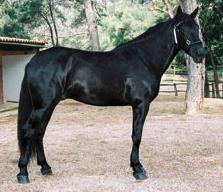


Country of Origin: Spain and Majorca, respectively.
"The Mallorquín or Caballo Mallorquín (Catalan: Cavall Mallorquí) is a rare breed of horse indigenous to the island of Majorca in the Balearic Islands, from which it takes its name. Identification of the breed was begun in 1985 by the Patronato para las Razas Autóctonas de Mallorca ('authority for the autochthonous breeds of Mallorca'). The Mallorquín is listed in the Catálogo Oficial de Razas de Ganado de España in the group of autochthonous breeds in danger of extinction. Its status was listed in 2007 as critical by the Food and Agriculture Organization of the United Nations. In approximately 2005 the number of Mallorquín horses recorded in the stud-book was 247, but a census conducted by the Ministerio de Medio Ambiente y Medio Rural y Marino in 2003 identified only 172. In some English-language publications, the Mallorquín and Menorquín are not listed, but horses of the Balearic Islands are merged into a grouping called the Balearic horse or Balearic pony. However, authoritative sources, including the Government of the Balearic Islands, the Ministerio de Medio Ambiente y Medio Rural y Marino of Spain and the Food and Agriculture Organization of the United Nations, make it clear that they are two separate breeds." W
Characteristics
For a horse to be registered Mallorquín it myst be only black. There may be white facial markings, however, no white on the legs. Female horses must be at least 14.2 hands and males 15 hands. The head is refined with a convex profile. The neck is arched, the mane thick and short. The bone structure is refined.
History
The Mallorquín and Menorquín genetically come from the Catalan horse which is now extinct. A genetic study of Spanish Celtic Horse Breeds showed that there was strong African influence into the original Celtic horses introduced to the Iberian Peninsulaa in the 8th centure BC. The study showed clear grouping of the two Mediterranean breeds and clear separation from the five 'Atlantic' Celtic breeds examined, the Asturcón, Gallego, Jaca Navarra, Losino and Pottok. ("Summary: Partition of the genetic variability, genetic structure and relationships among seven Spanish Celtic horse breeds were studied using PCR amplification of 13 microsatellites on 481 random individuals. In addition, 60 thoroughbred horses were included. The average observed heterozygosity and the mean number of alleles were higher for the Atlantic horse breeds than for the Balearic Islands breeds. Only eight percentage of the total genetic variability could be attributed to differences among breeds (mean Fst ;« 0.08; P < 0.01). Atlantic breeds clearly form a separate cluster from the Balearic Islands breeds and among the former only two form a clear clustering, while the rest of Atlantic breeds (Jaca Navarra, Caballo Gallego and Pottoka) are not consistently differentiated. Multivariate analysis showed that Asturcon populations, Losina and Balearic Islands breeds are clearly separated from each other and from the rest of the breeds. In addition to this, the use of the microsatellites proved to be useful for breed assignment." Wiley/The genetic structure of Spanish Celtic horse breeds inferred from microsatellite data ![]()
Uses
"This breed is used by the local population only as a riding horse; farm work in the islands was traditionally done by the Balearic donkey. Mallorquín mares were traditionally bred to imported stallions, usually of French Trotter or Orlov Trotter breed, to produce Trotador Español, 'Spanish Trotter', horses. Approximately 85% of the Spanish Trotter population is in Mallorca; however, genetic study has found little recent influence of the Mallorquín on the Spanish Trotter breed." W